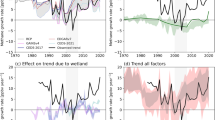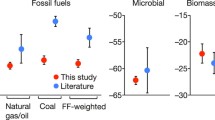Abstract
A simple methane model is presented in which lifetime changes are expressed as a function of CH4 concentration and emissions of NOx CO and NMHCs. The model parameters define the relative sensitivities of lifetime to these determining factors. The parameterized model is fitted to results from five more complex atmospheric chemistry models and to 1990 IPCC concentration projections. The IPCC data and four of the five models are well fitted, implying that the models have similar relative sensitivities. However, overall sensitivities of lifetime to changes in atmospheric composition vary widely from model to model. The parameterized model is used to estimate the history of past methane emissions, lifetime changes and OH variations, with estimates of uncertainties. The pre-industrial lifetime is estimated to be 15–34% lower than today. This implies that 23–55% of past concentration changes are due to lifetime changes. Pre-industrial emissions are found to be much higher (220–330 TgCH4/y) than the best estimate of present natural emissions (155 TgCH4/y). The change in emissions since pre-industrial times is estimated to lie in the range 160–260 TgCH4/y, compared with the current best guess for anthropogenic emissions of 360 TgCH4/y. These results imply either that current estimates of anthropogenic emissions are too high and/or that there have been large changes in natural emissions. 1992 IPCC emissions scenarios are used to give projections of future concentration and lifetime changes, together with their uncertainties. For any given emissions scenario, these uncertainties are large. In terms of future radiative forcing and global-mean temperature changes over 1990–2100 they correspond to uncertainties of at least ±0.2 Wm−2 and ± 0.1° C, respectively.
Similar content being viewed by others
References
Born M, Dörr GH, Levin I (1990) Methane consumption in aerated soils of the temperate zone. Tellus 42B: 2–8
Brasseur GP, Martinerie P, Granier C (1992) Modeling of ancient atmospheres using ice core data and a 2D model of atmospheric chemistry (abstr). Eos 73:108
Bruhl C, Crutzen PJ (1988) Scenarios of possible changes in atmospheric temperatures and ozone concentrations due to man's activities, estimated with a one-dimensional coupled photochemical climate model. Clim Dyn 2:173–203
Crutzen PJ, Zimmermann PH (1991) The changing photochemistry of the troposphere. Tellus 43AB:136–151
Fraser P, Penkett SA, Harriss R, Makide Y, Sanhueza E (1992) Source gases: concentrations, emissions and trends. In: Watson RT, Albritton DL (eds) Scientific assessment of ozone depletion: 1991. World Meteorological Organization and United Nations Environment Programme, Geneva (in press)
Guthrie PD, Yarwood G (1991) Analysis of the Intergovernmental Panel on Climate Change (IPCC) future methane simulations, SYSAPP-91/114. Systems Applications International, San Rafael, California
Hough AM (1991) Development of a two-dimensional global tropospheric model: model chemistry. J Geophys Res 96:7325–7362
Hough AM, Derwent RG (1990) Changes in the global concentration of tropospheric ozone due to human activities. Nature 344:645–648
Houghton JT, Jenkins GJ, Ephraums JJ (eds) (1990) Climate change: the IPCC Scientific Assessment. Cambridge University Press, Cambridge, UK
Houghton JT, Callander BA, Varney SK (1992) Climate Change 1992. The Supplementary Report to the IPCC Scientific Assessment. Cambridge University Press, Cambridge, UK
Isaksen ISA, Hov Ö (1987) Calculations of trends in the tropospheric concentration of 03, OH, CH4 and NOx. Tellus 3913:271–285
Isaksen ISA, Lee Y-P, Atkinson R, Sidebottom H, Fuglestvedt JA, Johnson C, Lelieveld J, Thompson A (1992) Tropospheric processes: observations and interpretations. In: Watson RT, Albritton DL (eds) Scientific assessment of ozone depletion: 1991. World Meteorological Organization and United Nations Environment Programme, Geneva (in press)
Khalil MAK, Rasmussen RA (1985) Causes of increasing atmospheric methane: depletion of hydroxyl radicals and the rise of emissions. Atmos Environ 19:397–407
Leggett J, Pepper WJ, Swart RJ (1992) Emissions Scenarios for IPCC: An Update. In: Houghton JT, Callander BA, Varney SK (eds) Climate change 1992. The Supplementary Report to the IPCC Scientific Assessment. Cambridge University Press, Cambridge, UK, pp 69–96
Levine JS, Rinsland CP, Tennille GM (1985) The photochemistry of CH4 and CO in the troposphere in 1950 and 1985. Nature 318:254–257
Mosier A, Schimel D, Valentine D, Bronson K, Parton W (1991) Methane and nitrous oxide fluxes in native, fertilized and cultivated grasslands. Nature 350:330–332
Pearman GI, Fraser PJ (1988) Sources of increased methane. Nature 332:489–490
Pepper W, Leggett J, Swart R, Wasson J, Edmonds J, Mintzer I (1992) Emission scenarios for the IPCC - an update: background documentation on assumptions, methodology, and results. US Environmental Protection Agency, Washington DC
Prather MJ (ed) (1989) An assessment model for atmospheric composition, NASA Conference Publication 3023. NASA/ Goddard Institute for Space Studies, New York
Prinn R, Cunnold D, Simmonds P, Alyea F, Boldi R, Crawford A, Fraser P, Gutzler D, Hartley D, Rosen R, Rasmussen R (1992) Global average concentration and trend for hydroxyl radicals deduced from ALE/GAGE trichloroethane (methylchloroform) data for 1978–1990. J Geophys Res 97:2445–2461
Rinsland CP, Levine JS, Miles T (1985) Concentration of methane in the troposphere deduced from 1951 infrared solar spectra. Nature 318:245–249
Shine KP, Derwent RG, Wuebbles DJ, Morcrette J-J (1990) Radiative forcing of climate. In: Houghton JT, Jenkins GJ, Ephraums JJ (eds) Climate change: The IPCC scientific assessment. Cambridge University Press, Cambridge, UK, pp 41–68
Staffelbach T, Neftel A, Stauffer B, Jacob D (1991) A record of the atmospheric methane sink from formaldehyde in polar ice cores. Nature 349:603–605
Steele LP, Dlugokencky EJ, Lang PM, Tans PP, Martin RC, Masarie KA (1992) Slowing down of the global accumulation of atmospheric methane during the 1980s. Nature 358:313–316
Stevens CM (1988) Atmospheric methane. Chem Geol 71:11–21
Striegl RG, McConnaughey TA, Thorstenson DC, Weeks EP, Woodward JC (1992) Consumption of atmospheric methane by desert soils. Nature 357:145–147
Sze ND (1977) Anthropogenic CO emissions: implications for the atmospheric CO-OH-CH4 cycle. Science 195:673–675
Thompson AM, Cicerone RJ (1986) Possible perturbations to atmospheric CO, CH4 and OH. J Geophys Res 91:10853–10864
Thompson AM, Huntley MA, Stewart RW (1990) Perturbations to tropospheric oxidants, 1985–2035. 1. Calculations of ozone and OH in chemically coherent regions. J Geophys Res 95:9829–9844
Vaghjiani GL, Ravishankara AR (1991) New measurement of the rate coefficient for the reaction of OH with methane. Nature 350:406–409
Watson RT, Rodhe H, Oeschger H, Siegenthaler U (1990) Greenhouse gases and aerosols. In: Houghton JT, Jenkins GJ, Ephraums JJ (eds) Climate change: The IPCC scientific Assessment. Cambridge University Press, Cambridge, UK, pp 1–40
Watson RT, Meira Filho LG, Sanhueza E, Janetos A (1992) Sources and sinks. In: Houghton JT, Callander BA, Varney SK (eds) Climate change 1992. The supplementary report to the IPCC scientific assessment. Cambridge University Press, Cambridge, UK, pp 25–46
Wigley TML, Holt T, Raper SCB (1991) STUGE (An interactive greenhouse model): user's manual. Climatic Research Unit, Norwich, UK
Wigley TML, Raper SCB (1992) Implications for climate and sea level of revised IPCC emissions scenarios. Nature 357:293–300
World Meteorological Organization (1985) Atmospheric ozone 1985: assessment of our understanding of the processes controlling its present distribution and change, WMO Global Research and Monitoring Project Rep no. 16. World Meteorological Organization, Geneva, pp 476–478
Author information
Authors and Affiliations
Rights and permissions
About this article
Cite this article
Osborn, T.J., Wigley, T.M.L. A simple model for estimating methane concentration and lifetime variations. Climate Dynamics 9, 181–193 (1994). https://doi.org/10.1007/BF00208251
Received:
Accepted:
Issue Date:
DOI: https://doi.org/10.1007/BF00208251




